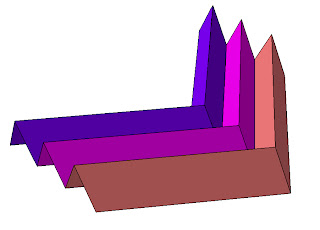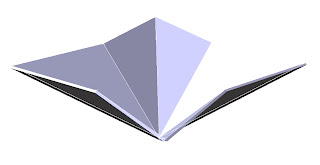http://nattapol-keeratiphantawong.com/KMITL%20Train%20Station
From archidose:
The idea of a "folding facade" is not entirely new. Shuttered exteriors have traditionally been used in various locales for protection from the elements, from New Orleans to New England in the United States, and in most other parts of the globe. What separates the newfound use of a folding perimeter to the traditional use is extent and purpose.

[Carabanchel Housing | photo by Francisco Andeyro Garcia and Alejandro Garcia Gonzalez]
The Carabanchel Housing in Madrid, Spain by
Foreign Office Architects strongly illustrates how the 20th-century shift to frame structures has made folding screens encompass the whole facade, as opposed to covering punched openings in load-bearing walls. This enables the character of the facade to be seen as ever-changing, as each occupant modifies their space to suit.

[Carabanchel Housing | photo by Francisco Andeyro Garcia and Alejandro Garcia Gonzalez]
In this design the folding facade is created from small bamboo rods in a metal frame. The architects originally chose perforated zinc, but the budget and contractor pointed towards bamboo, what turned out to be a difficult, time-consuming process, but one that yields a strong texture that exudes the handbuilt nature of the pieces.

[Carabanchel Housing | photo by Sergio Padura]
Both the Carabanchel Housing and the next two projects illustrate the primary function of folding facades today: modulating light, wind, and water. The bamboo screen filters, but the wood panels of House MM by
Fernando Menis in Santa Cruz de Tenerife are a solid barrier between inside and outside.

[House MM | image
source]
Equally solid is the folding facade of the Lohbach Residences in Innsbruck, Austria by
Baumschlater & Eberle, where copper panels sit on slab projections. In each of these three projects, the folding facade is but one layer in front of the "real" facade which is back by a balcony or terrace (on the penthouse of House MM). This creates a space between inside and outside, a gradient space aided by the flexibility of the facades.

[Lohbach Residences | image
source]
Where the residential buildings above preclude only one layer, Fabios Restaurant in Vienna by
BEHF Architekten makes the facade almost completely disappear via a clever vertical folding of the glass storefront. (New Yorkers who don't wish to fly to Europe to experience such a thing can head to the Lower East Side and
Spitzer's Corner.) Not only does the barrier become erased, it becomes a canopy, sheltering diners and passers-by on the sidewalk.

[Image description | image
source]
While these projects illustrates some consistencies in using folding facades, the last design shows that there's other creative ways in using them. Here's hoping for more creating ways of exploiting their potential in the future.


















































